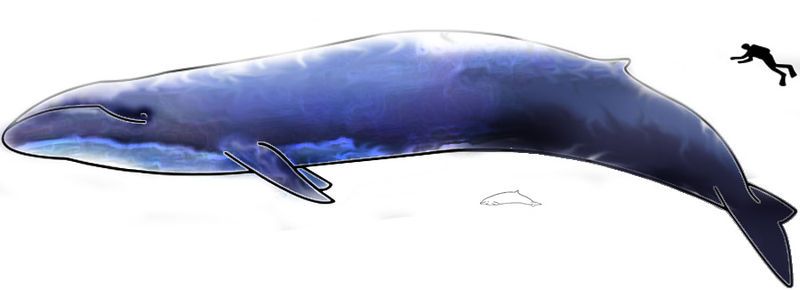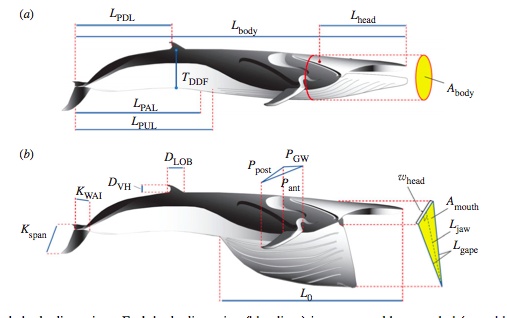
![]() The question is not why are whales big but why are whales not bigger? The blue whales reached weights of 150 tons prewhaling. To appreciate how massive a blue whale is, consider it would take 15 school buses, around 10 tons in weight to equal one of these marine mammals. Why are there no 250 tons superwhales?
The question is not why are whales big but why are whales not bigger? The blue whales reached weights of 150 tons prewhaling. To appreciate how massive a blue whale is, consider it would take 15 school buses, around 10 tons in weight to equal one of these marine mammals. Why are there no 250 tons superwhales?
This is been a pet project of mine for sometime along with why the giant isopod isn’t the size of two shoes instead of one, why the giant squid only reaches a measly half ton, and why snails are not the size of trashcans? Along with pet projects come pet hypotheses. For the blue whale, I considered that maybe there were constraints on the heart and circulatory system. Consider that a blue whale’s heart is size of Volkswagen Beetle and must pump blood over 100 feet. Over the length of the whale blood passes through a set of tubes encountering friction along the walls of arteries and vessels, meeting resistance in capillaries, and the splitting of viscous liquid at junctions. A whole field developed, fluid dynamics, to deal with the complexities of such problems, but to simply it means a lot of work for a pump. Think also about how municipal water supplies are arranged. There are multiple pumping stations throughout a municipality not just an increasingly large pump at the center. This is because pumps become increasing inefficient at moving liquids over greater and greater distances, i.e. a satellite pump is needed to overcome the forces of friction in a tube or pipe. Maybe the whale is a big as it can be for its pump, i.e. the heart, to efficiently drive blood to the whale ends. Maybe the whale needs a second pump?
As speculative as my first idea, I also considered another. Perhaps there is something about the amount of food a blue whale requires? Can the density of krill limit blue whale size? Consider krill aggregations typically occur in upwelling, and thus cold-water areas. For a blue whale to feed it must be in cold water. However, a blue whale cannot calf in cold water, as “little one” would not be able to thermoregulate, i.e. keep warm. Thus, blue whales, like many other whales, move to warmer waters to calve. The calves consume 100-150 gallons of mile a day and weaning takes place for about six months. This weaning period is considerably shorter than you would expect for a mammal this size predicted from the mass/weaning relationship of other mammals. A female then must be in two places at once in order to feed and calve. Perhaps this imposes a set of constraints on blue whale size? Further increases in size push the mass/weaning constraint and require more fat reserves than a female could possibly store.
Goldbogen et al. propose another idea supported with a great deal more theory, mathematics, and data than my pint-driven conjectures above. Rorqual whales feed by lunge-feeding, the process of enlarging the mouth and swallowing a large volume of prey laden water. This is energetically very expensive as a open mouth serves a parachute increasing drag, not to mention carrying a massive engulfed mouth full of water. The total engulfed volume is a function, or scales with, the size of the skull and mount. A relationship is considered isometric if an increase in size comes with the same proportion increase in trait or characteristic measured, in this case engulfing volume. The relationship is allometric if the rate of increase of the measure characteristic goes up or down with increased size, i.e. larger sizes do better or worse than smaller size per unit of body size. For example, time of weaning versus mass discussed above is an allometric relationship for mammals. In the paper here, the authors find that in larger fin whales the skull and mouth cavities are larger than that predicted by size alone, i.e. allometric. Bigger whales possess disproportionally larger mouths for the increase in engulfment capacity, pound for pound, of an individual. This greater feeding capability is required for these larger whales.

However, the authors find these allometric relationships do not go unchecked. First, bigger heads also often come with reduction of the anterior end as the whale “makes a choice” to invest energy in growth of the head or tail. Second, this increased engulfment capacity may limit due to drag the depth in which larger whales can dive. Given that krill descend at night this represent a considerable negative. As the authors state even if whales are optimized for engulfment capacity with each lunge, the energy expended with eventually be greater than the energy gained. Thus, superwhales may be out the question unless whales can escape this evolutionary trajectory. Which begs the question, will they still be whales?
Goldbogen, J., Potvin, J., & Shadwick, R. (2009). Skull and buccal cavity allometry increase mass-specific engulfment capacity in fin whales Proceedings of the Royal Society B: Biological Sciences DOI: 10.1098/rspb.2009.1680






during certain periods in the planets early history, the earth had much higher density of oxygen allowing for such things as ten feet long centipedes, i would think that, what your question lacks is a longer perspective, whales are still evolving and getting bigger compared to fossil records.
Undoubtedly if there were, we’d have hunted them to extinction by now.
perhaps if the blue whales dined upon giant isopods…. ;)
Quick question: why do we think that whales are done getting big? Blues and fins have been around for maybe 5 million years tops, and the biggest known whales of all time are blues caught in the 20th century. We might be catching the biggest rorquals in the act of getting even bigger–but there’s no way to know without a time machine that goes forward, or extreme patience and a few million years’ worth of funding. So it seems fruitless to speculate about what is limiting the size of big whales when we don’t have any evidence that they have maxed out yet.
@Matt and Stella
While I I do understand that viewing contemporary life is simply a snapshot in time, I don’t think it is fruitless to speculate or research why things are the current size they are. All of these are exercises on what limits size. Modern life bears the signature of evolution past and thus questions about current forms are rich with insight (e.g. McClain and Boyer 2009 in Royal Society Proc B).
Current estimates put the split of blue whales at ~15 +/- 3 Ma and the split of Baleen whales at ~23 +/- 2.5 Ma (Sasaki et al. 2005). Either 15 or 5 Ma is a pretty long time for a increase in size to occur? There are multiple studies showing rapid changes in size over mere decades (Huey and Gilchrist) to thousands of years (Smith et al. 1995). Granted the examples come from species much smaller but there is no indication that it is easier for a small organism to increase its size compared to a large one. There is also little evidence of major shifts in size in the last 20 million years (http://www.nceas.ucsb.edu/~alroy/Paleocene.html). Nonetheless a ripe area of research with many outstanding questions.
Also consider that whales are simply one example, but there is evidence from multiple phyla that morphological extremes are reached very early in a clades history, often indicating constraints on form.
@ Stella
Indeed oxygen is important for the size of life see the paper I coauthored in PNAS with colleagues at http://www.pnas.org/content/106/1/24.abstract that provides a long term and broad taxonomic perspective.
Inasmuch as all conjecture above is incorrect, permit me to give you a clue.
If you can simultaneously “explain” why humpack whales, Megaptera novaeangliae, are characterized by extremely long pectoral flippers, carry armament in the form of barnacle patches on their chins and on tuberosities on this pectoral flippers, and have disproptionately thick blubber compared with balaenopters, you will get the answer.
As encouragement, be assured that the resultant equation of constraint is more than interesting.